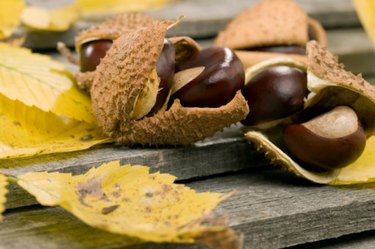
People colloquially call trees and shrubs in the botanical genus Aesculus either buckeye or chestnut trees. Twelve species exist, native to North America, southeastern Europe or eastern Asia. The name "buckeye" is an American term, referring to the fruit-nuts of native species that look like an eye of a buck deer. The most famous species remains the Ohio buckeye (Aesculus glabra), well-known as a university mascot and the Ohio state tree. However, it's not the only species referred to as a buckeye.
American Native Species
Video of the Day
Besides the Ohio buckeye, other tree species called buckeyes include California buckeye (A. californica), yellow buckeye (A. flava, also known as A. octandra) and red buckeye (A. pavia), which develop into large plants. Remaining smaller and more shrublike are bottlebrush buckeye (A. parviflora) and the painted buckeye (A. sylvatica). By contrast, members of the genus native to Asia or Europe are dubbed horse chestnuts, never buckeyes.
Video of the Day
The Buckeye
A buckeye fruit looks rounded or pear-shaped and ripens to a beige color by late summer. The leathery fruit skin is either smooth or sparsely covered in tiny spines. Split the fruit open to reveal one or two seeds -- the buckeye. It matures dark brown to brown-black in color. The hilum or scar left from attachment, is a contrasting light beige and creates the look of an eye. Squirrels eat buckeyes readily, but they are toxic to humans in great quantities because of the chemical compound aesculin. Consuming one nut may lead to mild stomach upset.
Buckeye Trees in Ohio
To an Ohioan, a little more knowledge is needed to ensure identification of the Ohio buckeye from the yellow buckeye. Both trees grow throughout the state. The Ohio buckeye tree matures smaller, anywhere from 20 to 40 feet tall and equally wide. Its fruits are round with one buckeye inside. Conversely, the yellow buckeye grows much more massive when old -- 60 to 75 feet tall and 30 to 50 feet wide. Its fruits attain a pear-shape and split open to reveal one or two buckeyes.
Formation of Buckeyes
Buckeye trees only develop fruits when bumblebees or honeybees pollinate the mid- to late-spring flowers. Both tree and shrub forms of buckeyes produce upright cluster spikes of small blossoms, ranging from white to cream or coral-red depending on species. Rarely do all flowers in a cluster form fruits. Usually one to four fruits form where a floral cluster appeared on branch tips. Not all branch tips may develop fruits, however.